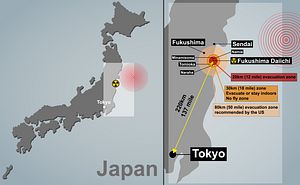After suggesting on Sunday that an evacuation advisory might be lifted for a portion of the town of Kawauchi near the Fukushima Daiichi nuclear power plant, the Environment Ministry on Monday announced that the ban on inhabiting the area will be lifted on October 1. The town, located within the exclusion zone of 20 km of the stricken power plant, was home to 3,000 people before the March 2011 earthquake and tsunami. Additionally, the first exports of rice from Fukushima prefecture since the disaster have reached Singapore, in what is hoped to be the beginning of revitalizing one of Japan’s largest agricultural producing regions. Although there are signs that the region affected by the nuclear disaster could start to see some level of normalcy, the cleanup efforts and the stigma surrounding the region will take much longer to overcome.
Environment Ministry officials said on Monday that radiation cleanup efforts in the eastern portion of Kawauchi had been finished and the ban would be lifted, although residents had already been allowed to make short visits to the area after an initial cleanup. This is only the second district within the exclusion zone to have the ban removed, after residents of the Miyakoji district in Tamura were allowed to return in April. The government’s cleanup efforts for this area have fallen behind mainly due to its inability to find places willing to house the waste for long-term storage.
Additionally, Fukushima prefecture has resumed the export of rice that was halted immediately after the 2011 nuclear disaster. Kashihikari brand rice has sent 300 kg of rice to Singapore, which is expected to be sold on Friday once it clears customs, according to the National Federation of Agricultural Cooperative Associations. In the year up to the disaster in March 2011, Fukushima prefecture exported 100 tons of rice. Singapore lifted its ban on food products from Fukushima in May, and Japanese exports of marine and agricultural goods in general increased 10.3 percent year on year between January and June of this year.
While this is good news for both the residents of the exclusion zone and the prefecture’s agricultural industry in general, returning to normal life and production levels before the disaster will be difficult for the foreseeable future. With only two small districts within the exclusion zone allowed to return after three years of cleanup efforts, the problem of finding municipalities willing to store the waste is becoming acute. Additionally, the stigma attached to Fukushima agricultural products will not be easily solved, as many countries still ban these goods, and many Japanese themselves are still leery of eating them. The government will have to find ways to further reassure consumers, while finding a transparent and long-term solution to the cleanup effort.

































